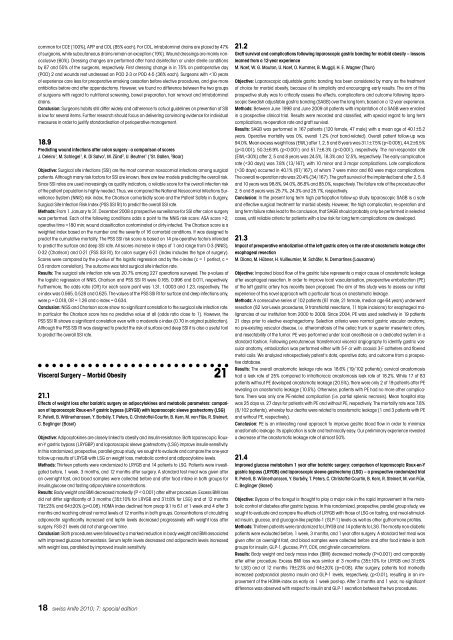Anorectal Manometry in 3D NEW! - Swiss-knife.org
Anorectal Manometry in 3D NEW! - Swiss-knife.org
Anorectal Manometry in 3D NEW! - Swiss-knife.org
You also want an ePaper? Increase the reach of your titles
YUMPU automatically turns print PDFs into web optimized ePapers that Google loves.
common for CCE (100%), APP and COL (85% each). For COL, <strong>in</strong>trabdom<strong>in</strong>al dra<strong>in</strong>s are placed by 47%<br />
of surgeons, while subcutaneous dra<strong>in</strong>s rema<strong>in</strong> an exception (19%). Wound dress<strong>in</strong>gs are ma<strong>in</strong>ly nonocclusive<br />
(60%). Dress<strong>in</strong>g changes are performed after hand dis<strong>in</strong>fection or under sterile conditions<br />
by 87 and 55% of the surgeons, respectively. First dress<strong>in</strong>g change is <strong>in</strong> 75% on postoperative day<br />
(POD) 2 and wounds rest undressed on POD 2-3 or POD 4-5 (36% each). Surgeons with 2;<br />
operative time >180 m<strong>in</strong>; wound classification contam<strong>in</strong>ated or dirty-<strong>in</strong>fected. The Charlson score is a<br />
weighted <strong>in</strong>dex based on the number and the severity of 16 comorbid conditions. It was designed to<br />
predict the cumulative mortality. The PSS SSI risk score is based on 14 pre-operative factors <strong>in</strong>tended<br />
to predict the surface and deep SSI rate. All scores <strong>in</strong>crease <strong>in</strong> steps of 1 and range from 0-3 (NNIS),<br />
0-32 (Charlson) and 0-21 (PSS SSI RI), for colon surgery 6-21 (<strong>in</strong>dex <strong>in</strong>cludes the type of surgery).<br />
Scores were compared by the p-value of the logistic regression and by the c-<strong>in</strong>dex (c = 1 perfect, c =<br />
0.5 random correlation). The outcome was total surgical site <strong>in</strong>fection rate.<br />
Results: The surgical site <strong>in</strong>fection rate was 20.7% among 227 operations surveyed. The p-values of<br />
the logistic regression of NNIS, Charlson and PSS SSI RI were 0.165, 0.996 and 0.011, respectively.<br />
Furthermore, the odds ratio (OR) for each score po<strong>in</strong>t was 1.31, 1.0003 and 1.23, respectively. The<br />
c-<strong>in</strong>dex was 0.565, 0.528 and 0.625. The values of the PSS SSI RI for surface and deep <strong>in</strong>fections only,<br />
were p = 0.018, OR = 1.26 and c-<strong>in</strong>dex = 0.634.<br />
Conclusion: NISS and Charlson score show no significant correlation to the surgical site <strong>in</strong>fection rate.<br />
In particular the Charlson score has no predictive value at all (odds ratio close to 1). However, the<br />
PSS SSI RI shows a significant correlation even with a moderate c-<strong>in</strong>dex (0.70 <strong>in</strong> orig<strong>in</strong>al publication).<br />
Although the PSS SSI RI was designed to predict the risk of surface and deep SSI it is also a useful tool<br />
to predict the overall SSI rate.<br />
Visceral Surgery – Morbid Obesity 21<br />
21.1<br />
Effects of weight loss after bariatric surgery on adipocytok<strong>in</strong>es and metabolic parameters: comparison<br />
of laparoscopic Roux-en-Y gastric bypass (LRYGB) with laparoscopic sleeve gastrectomy (LSG)<br />
R. Peterli, B. Wölnerhanssen, Y. Borbély, T. Peters, C. Christoffel-Court<strong>in</strong>, B. Kern, M. von Flüe, R. Ste<strong>in</strong>ert,<br />
C. Begl<strong>in</strong>ger (Basel)<br />
Objective: Adipocytok<strong>in</strong>es are closely l<strong>in</strong>ked to obesity and <strong>in</strong>sul<strong>in</strong>-resistance. Both laparoscopic Rouxen-Y<br />
gastric bypass (LRYGBP) and laparoscopic sleeve gastrectomy (LSG) improve <strong>in</strong>sul<strong>in</strong>-sensitivity.<br />
In this randomized, prospective, parallel-group study, we sought to evaluate and compare the one-year<br />
follow-up results of LRYGB with LSG on weight loss, metabolic control and adipocytok<strong>in</strong>e levels.<br />
Methods: Thirteen patients were randomized to LRYGB and 14 patients to LSG. Patients were <strong>in</strong>vestigated<br />
before, 1 week, 3 months, and 12 months after surgery. A standard test meal was given after<br />
an overnight fast, and blood samples were collected before and after food <strong>in</strong>take <strong>in</strong> both groups for<br />
<strong>in</strong>sul<strong>in</strong>,glucose and fast<strong>in</strong>g adipocytok<strong>in</strong>e concentrations.<br />
Results: Body weight and BMI decreased markedly (P < 0.001) after either procedure. Excess BMI loss<br />
did not differ significantly at 3 months (35±10% for LRYGB and 31±8% for LSG) and at 12 months<br />
79±23% and 64±20% (p=0.08). HOMA <strong>in</strong>dex decl<strong>in</strong>ed from preop 9.1 to 6.1 at 1 week and 4 after 3<br />
months and reach<strong>in</strong>g almost normal levels at 12 months <strong>in</strong> both groups. Concentrations of circulat<strong>in</strong>g<br />
adiponect<strong>in</strong> significantly <strong>in</strong>creased and lept<strong>in</strong> levels decreased progressively with weight loss after<br />
surgery. FSG-21 levels did not change over time.<br />
Conclusion: Both procedures were followed by a marked reduction <strong>in</strong> body weight and BMI associated<br />
with improved glucose homeostasis. Serum lept<strong>in</strong> levels decreased and adiponect<strong>in</strong> levels <strong>in</strong>creased<br />
with weight loss, paralleled by improved <strong>in</strong>sul<strong>in</strong> sensitivity.<br />
18 swiss <strong>knife</strong> 2010; 7: special edition<br />
21.2<br />
Graft survival and complications follow<strong>in</strong>g laparoscopic gastric band<strong>in</strong>g for morbid obesity – lessons<br />
learned from a 12-year experience<br />
M. Naef, W. G. Mouton, U. Naef, O. Kummer, B. Muggli, H. E. Wagner (Thun)<br />
Objective: Laparoscopic adjustable gastric band<strong>in</strong>g has been considered by many as the treatment<br />
of choice for morbid obesity, because of its simplicity and encourag<strong>in</strong>g early results. The aim of this<br />
prospective study was to critically assess the effects, complications and outcome follow<strong>in</strong>g laparoscopic<br />
Swedish adjustable gastric band<strong>in</strong>g (SAGB) over the long term, based on a 12-year experience.<br />
Methods: Between June 1998 and June 2009 all patients with implantation of a SAGB were enrolled<br />
<strong>in</strong> a prospective cl<strong>in</strong>ical trial. Results were recorded and classified, with special regard to long term<br />
complications, re-operation rate and graft survival.<br />
Results: SAGB was performed <strong>in</strong> 167 patients (120 female, 47 male) with a mean age of 40.1±5.2<br />
years. Operative mortality was 0%, overall 1.2% (not band-related). Overall patient follow-up was<br />
94.0%. Mean excess weight loss (EWL) after 1, 2, 5 and 8 years was 31.1±7.5% (p
















